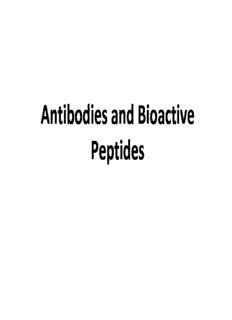
Antibodies and Bioactive Peptides - Iowa State University PDF
Preview Antibodies and Bioactive Peptides - Iowa State University
Antibodies and Bioactive Peptides Immune System • Composed of a complex constellation of cells, organs and tissues • Arranged in an elaborate and dynamic communication network • Equipped to optimize the response against invasion by pathogenic organisms and foreign materials Immune systems – Antigen specific: recognize and act against particular antigen – Systemic: not confined to the initial infection site, but work throughout the body – Memory: recognize antigens and mount an even stronger attack to the same antigen the next time. Memory B and T cells Dual Natures of Immune System • Self/non‐self recognition: the most important • General/Specific • Natural/adaptive = innate/acquired • Cell‐mediated/humoral • Active/passive • Primary/secondary Self/non‐self Recognition • Self recognition is achieved by a marker based on major histo compatibility complex (MHC) • Any cell not displaying this marker is treated as non‐self and attac ked • Undigested proteins are treated as antigens • Autoimmune diseases: attack of self cells (multiple sclerosis, arthr itis, diabetes etc.) • Allergy: An inappropriate immune response to harmless subst ances – Allergen: Substances that elicits allergy Transport Systems for the Agents of the Immune System • Lymphocytes circulate in the blood and lymph systems • Lymph systems: – Primary organs: bone marrow and thymus gland – Secondary organs: At possible portal of entry for patho gens • Adenoids, tonsil, spleen, lymph nodes, Peyer’s patches (withi n the intestines), the appendix Blood System 7% of body weight 52‐62% liquid plasma and 38‐48% cells Manufactured by stem cells in bone marrow Erythrocytes (RBC) Leucocytes (WBC) Granulocytes Neutrophils (55‐70%), ‐polymorphonuclear leucocytes Eosinophils (1‐3%), Basophils (0.5‐1.0%) Agranulocytes Lymphocytes (20‐40%); B‐cells, T‐cells Monocytes (1‐6%) mature into macrophage (big eater) Thrombocytes (platelets) macrophage From:http://uhaweb.hartford.edu/BUGL/immune.htm Basic Strategies of Immune System • Creating and maintaining a barrier that prevents bacteria and viruses from entering the body. • If a pathogen gets into the body, the innate immune system detect or eliminate the invader before it is able to reproduce and cause potentially serious injury to the host. • If a pathogen is able to successfully evade the innate immune cells, the immune system activates a second, adaptive immune response against the pathogen. Innate Immunity • The basic resistance to disease that a species possesses • Th e first line of defense against infection. • The characteristics of the innate immune response: – Re sponses are Broad‐Spectrum (non‐specific) – No m emory or lasting protective immunity – All an tigens are attacked equally – Bind t o antigen using pattern‐recognition receptors – Encod ed in the gene and passed from generation to gener ation Functions of the innate immune system • Recruiting immune cells to sites of infection, through the production of chemical factors ‐ cytokines. • Activation of the complement cascade to identify bacteria, activate cells, and to promote clearance of de ad cells or antibody complexes . • Identification and removal of foreign substances by white blood cells. • Activation of the adaptive immune system
Description: